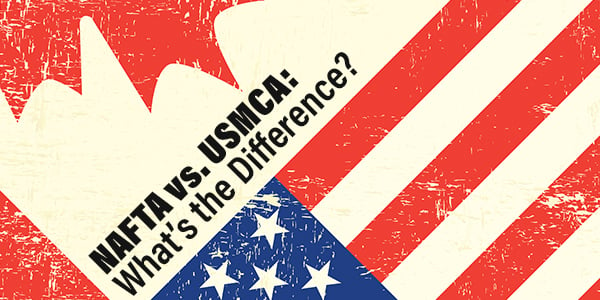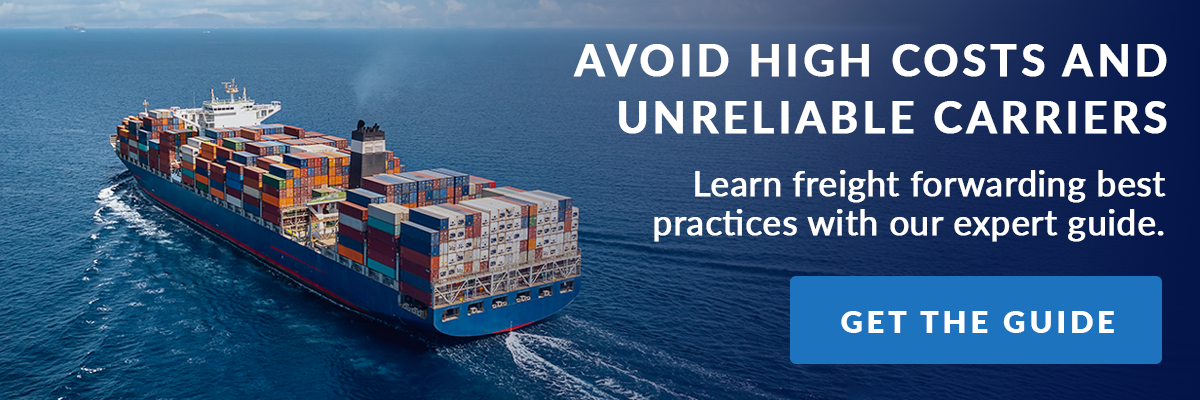
The U.S.-Mexico-Canada Agreement (USMCA) shares many similarities with its precursor, the North American Free Trade Agreement (NAFTA). However, there are key differences to consider when importing or exporting goods to these countries.
The more familiar you are with how USMCA has changed trade between the U.S., Mexico, and Canada, the easier it will be to abide by the new agreement.
What is NAFTA?
The North American Free Trade Agreement, or NAFTA, was enacted in 1994, creating a free-trade zone between Canada, Mexico, and the United States. NAFTA made it easier for the three countries to move goods and supplies across North America’s borders.
The agreement eliminated tariffs and quotas on U.S. exports to Mexico and Canada. And if U.S. companies imported goods from one of these countries, they did not have to pay duties.
Exporters filled out a NAFTA Certificate of Origin when goods qualified for NAFTA and submitted it to Customs for duty-free consideration.
What is USMCA?
USMCA, enacted in July 2020, replaced the nearly 25-year-old free trade agreement with one designed to create more balanced and equitable trade. USMCA includes a “sunset provision” that requires all three countries to re-evaluate and renew the pact in 16 years.
The bulk of the agreement refreshed NAFTA terms while also making certain significant changes, such as for automotive goods and sets. Companies must do their due diligence when claiming duty-free status under USMCA to address these changes. They must:
- Follow the new (and sometimes more complex) rules to the letter and claim carefully
- Keep track of every aspect of what goods are being sourced and from where
- Solicit the help of a freight forwarder or customs broker with a compliance team to help you navigate the requirements
- Hire a lawyer or customs consultant when trouble arises in complicated cases lacking solid proof of eligibility
RELATED CONTENT: WHAT IS TRANSSHIPMENT?
How Has USMCA Changed?
Though USMCA rehashed many NAFTA provisions, six key changes occurred when it was introduced.
- USMCA eliminates the NAFTA Certificate of Origin. The pact establishes new procedures to authorize certifications by importers, exporters or producers. For instance, if invoices confirm that goods meet USMCA eligibility requirements, they are eligible.
While it’s easier than ever to claim duty-free status, it’s essential to gather proper proof before doing so. Customs has upped its enforcement efforts and conducts audits more frequently under USMCA than NAFTA. Companies should:
- Keep all relevant documentation
- Maintain a history of materials used in its products
- Know the tariff numbers eligible for free trade status
As you claim free trade status, remember the rules of the game. Just because a product ships out of your country does not mean it meets Country of Origin requirements. For example, if you buy parts from China and build the final product in the United States without fundamentally changing the character of the Chinese parts, your goods most likely will not qualify. But if you buy steel from China, then melt it down to create a bike frame, your final product will be eligible.
- USMCA includes a labor chapter that prioritizes labor obligations. The USMCA strengthens labor laws to combat domestic manufacturers’ claims that too many jobs go to Mexico. Including these mandates in the USMCA makes the standards fully enforceable by Customs. The shift allows the U.S. to levy enforcement actions against factories that do not comply with domestic freedom of association and collective bargaining laws. The rule levels the playing field for workers and protects their rights.
- Digital record-keeping also changed to protect intellectual property. The USMCA readies trade for technology innovations. The new trade deal prohibits Canada and Mexico from requiring U.S. businesses to store customer and client data on servers within these countries. U.S. companies also cannot be sued over content appearing on websites in Canada and Mexico.
- The pact puts a heavier focus on environmental protection to focus on today’s heightened environmental concerns. It earmarked $600 million to address environmental concerns in North America and made environmental regulations easier to enforce.
- USMCA contains provisions designed to strengthen automobile sales and manufacturing jobs. The pact requires that 75% of a vehicle’s parts be manufactured in the United States, Canada, or Mexico. In contrast, NAFTA only required 62.5% of a vehicle’s parts to be manufactured within North America.
- The agreement also affects agricultural trade agreements established by NAFTA. USMCA keeps NAFTA tariffs, which were set at zero, for most agricultural products. But it also facilitates increased agricultural trade between the U.S. and Canada. Under the new agreement, Canada agreed to allow more American dairy, poultry, and eggs to cross the border into their country, and the U.S. agreed to allow more Canadian dairy, peanuts, peanut products, and limited amounts of sugar into the States.
The takeaway: while USMCA contains many of NAFTA’s provisions, it also made a number of changes. Companies need to do their homework before claiming USMCA preferential treatment to confirm compliance with the new trade agreement elements.




